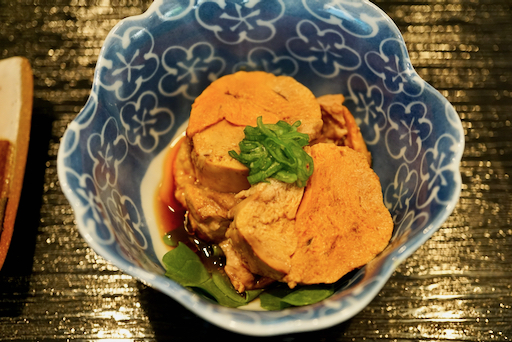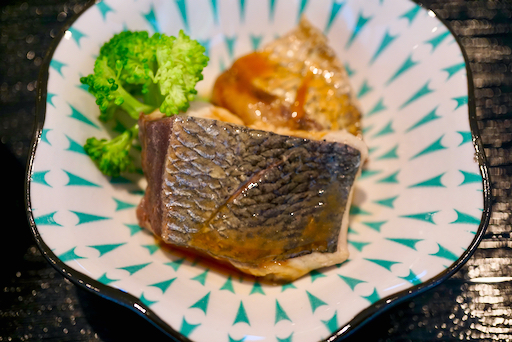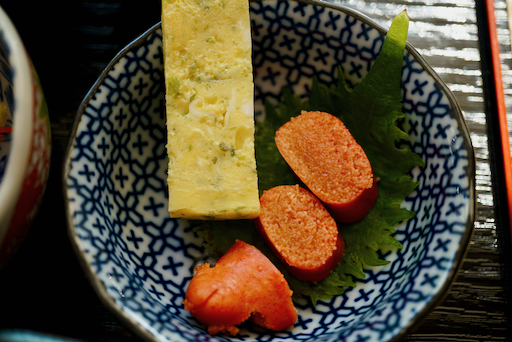We somehow feel really good that we can get Japanese food items from our Japanese grocery store again. It made us feel like there may be light at the end of this covid tunnel. We really like to start our evening with a little bit of sashimi.
Tuesday, June 15, 2021
Sashimi from Japanese grocery store 日本食料店からのはまち刺身
We somehow feel really good that we can get Japanese food items from our Japanese grocery store again. It made us feel like there may be light at the end of this covid tunnel. We really like to start our evening with a little bit of sashimi.
Saturday, June 12, 2021
Eggplant stir fried with sweet miso 茄子の味噌炒め
This is the eggplant dish I made with the last remaining Japanese (Asian) eggplant we recently got from Hmart (left in the first picture). I served this with bluefish simmered in miso ブルーフィッシュの味噌煮 (right).
Ingredients for the eggplant (makes about 8 of the small servings in the first picture):
1 Japanese eggplant (this was a big one about 10 inch long), stem end removed, skin peeled in strips and cut into bite sized pieces ("Ran-giri" 乱切り) then soaked in salted water to 10-15 minutes.
2 tsp neutral oil (I used light olive oil) for frying
1 tsp grated ginger root
For miso seasoning (Dissolve the below in a small bowl)
2 tbs sake
2 tsp red miso
2 tsp mirin
Directions:
Sauté the eggplant in a frying pan with the oil on medium flame until the oil is absorbed and the eggplant is soft (few minutes).
Add the ginger and then the seasoning and stir for a few minutes.
I served with white sesame seeds as garnish.
Wednesday, June 9, 2021
Bluefish "sanga" fish cake ブルーフィシュのサンガ
Blue fish meat scraped off the bone, tail and other parts, hand chopped using a heavy Chef’s knife, about 150grams (a guess)
Red miso 1 tbs
Ginger cut finely, 1 tsp plus ginger juice from grated ginger (about 1/2 tsp)
Scallion, 4 stalks, finely chopped
Potato starch (katakuri-ko) 2 tsp
Dark sesame oil 1/2 tsp
Perilla leaves (4-6 depending on the size)
Directions:
Mix all ingredients well except for the perilla leaves.
Divide the mixture into 6 equal portions.
Lightly oil hands and make the portions into flat discs and place the perilla leaves on one side (#1) in the third picture).
On a medium low flame with a small amount of neutral oil, first cook the side without perilla leaves until nicely browned (#2).
Flip it over and cook the other side for another 1 minute or so or until done (#3 and #4).
This is a good way to use scrap fish meat from the bluefish. The double doses of ginger juice and finely chopped ginger add ginger flavor but not overwhelmingly so. The miso flavor and sesame oil are a good combination. I am not sure if I can taste the perilla leaves. It warmed up nicely by microwaving.
Sunday, June 6, 2021
Raised Buckwheat Blini cooked in a “platar”
Ingredients:
For Blini (makes about 21 blini)
1 1/2 cup milk
4 Tbs. (1/2 stick) butter
2 tsp. yeast
2/3 cup AP flour
2/3 cup buckwheat flour
2 Tbs. sugar
1 tsp. salt
3 large eggs, lightly beaten
For Blini (recipe X2) (mix in the 6 cup pyrex mixing cup so the batter can be poured rather than scooped into the cooking cups.)
3 cup milk
4 tsp. yeast
1 1/3 cup AP flour
1 1/3 cup buckwheat flour
4 Tbs. sugar
2 tsp. salt
6 large eggs, lightly beaten
For topping (everything is to taste and depends on the number of pancakes being served. Also anything can be used. This is just what we came up with.)
sour cream (to taste)
2 eggs, scrambled
1 Tbs. Ikura (salmon eggs) or caviar
Chives finely chopped
Directions:
For the Blini: Melt the butter in the milk. Let it cool to about 105 to 115 degrees. Mix the dry ingredients (yeast through salt) in another bowl. Pour the cooled milk mixture over the dry ingredients mixing until just combined. Cover the bowl with plastic wrap and let it rise in a warm place until doubled in volume (about 1 hour) (#1 in the 3rd group of pictures). Once it has risen either make the pancakes immediately or refridgerate covered for up to 24 hours. (We made the batter after dinner and refridgerated it over night). If refridgerated let it stand at room temperature for 20 minutes (#2). Then deflate the batter and whisk in the eggs lightly beaten.
Now, I am providing the details of how I cooked blini in the platar. This is for our future reference because this requires some finesse. First, I took out the planar and washed it with hot water (no soap), dried it by heating it on the stove and coated each of the 7 wells with olive oil using a paper towel (#3). I preheated the pan on low flame for 5 minutes then used a small ladle (second smallest ice cream scoop) add the batter, half filling the wells (#4). I continued to cook until the surface of the pancake showed bubbles and looked dry (5-7 minutes). Then came the challenge of flipping them. According to my wife, the directions in the JOC said flip the pancakes over using a skewer. But that proved entirely too simplistic. After some experimentation I came up with a method of loosening the blini by running the tip of a dinner knife around the perimeter of the well, then inserting the knife tip under the bottom of the blini to pry it loose. Then with the knife under the blini and a bamboo skewer inserted into the top I flipped it (#5). As I repeated the process I got better and could flip the pancake without damaging the side. But I noticed that the 6 wells surrounding the center well had uneven heat and only the outer half got browned (#5). So with the next batch, I released the blini before they were ready to flip and turned them180 degrees in the well then cooked them for a few more minutes before flipping them over. In the next batch, the first side was more evenly browned (#6). In any case, when all was said and done, we had at least a few perfect blinis (#7= top and #8=bottom).
This is the height of decadence. The blini had a soft thick texture and a very pleasing robust rustic flavor from the combination of buckwheat flour and yeast. The sour cream, eggs and salmon caviar were an excellent combination with complementary creamy texture. The burst of saltiness from the ikura at the end of the bite was a perfect finale. This is how we will be making blini in the future. Next stop crumpets in the platar.
Thursday, June 3, 2021
Mint and pea kakiage ミントと豌豆のかき揚げ
Sometime ago, I saw this recipe in the web version of a Japanese newspaper. I thought mint and pea kakiage (a type of tempura made with several small food items) かき揚げ was very interesting and unique but was dragging my feet in actually making it. The mint crop is flourishing in our herb garden and my wife harvested some to make mint tea recently. She reserved some mint leaves for me to use for this kakiage (so I found myself fresh out of any excuses for not making it.) Finally, I made this dish one weekend evening. I served it with wedges of lemon and green tea salt.
Ingredients (I did not precisely measure anything but it made four kaiage tempura).
About 1 cup of fresh mint leaves, washed and dried.
About 1/2 cup of peas (I used frozen petit peas, thawed).
Cake flour for dusting.
Peanut oil for frying.
For Tempura batter
About 1/2 cup cake flour
Cold carbonated water.
Directions:
Lightly dust the mint leaves and peas with the cake flour (#1 in the third picture)
Mix the cake flour and the carbonated water to make thin tempura batter and add the peas and mint leaves (#2)
Using a slotted spoon, I scooped up the mint and peas and slid the clump into the hot oil (350F) (#3)
Turning once, I fried them until crispy and slightly golden then drained them (#4)
We couldn’t taste much of the peas but this was very light, airy and crunchy with refreshing mint flavor. Perilla leaves, which are a bit similar to mint leaves, are a standard tempura item which I have used in several variations but mint leaves are certainly unique. Since we have a good supply of fresh mint leaves during the summer, we might try this in different combination...asparagus and mint immediately comes to mind.
Addendum
I made this dish again a few days later. I also found the original recipe and only thing I missed was adding potato starch (should equal 1/2 the amount of cake flour used). I also added fresh corn. I lowered the hot oil temperature to avoid browning. All worked better.
Monday, May 31, 2021
Tarako from Korean grocery store Hmart 焼きたらこ
Lightly grilled salted "tarako" たらこ cod roe is not really a new dish as I posted it many years ago, but it is a very common dish in Izakaya and goes perfectly well with sake. I usually get tarako (frozen) from our Japanese grocery store, but this time I got it from Hmart, the Korean grocery store, through Instacart. The groceries were delivered while I was not at home so my wife received them. During a subsequent phone call, she mentioned that it was not a completely successful grocery run since the three types of fresh mushrooms and the mackerel we ordered were not available. The good news was that the "tarako" did arrive. She said something was wrong, however, because it was covered with a red goopy stuff and suggested that maybe the little egg sacks had somehow ruptured spilling their contents. (Not good!) So when I got back in the evening and inspected the tarako I found it was coated with a Korean hot sauce "gochujang". We were both relieved and had a good chuckle. Since we are not into very hot spicy food, I quickly rinsed off the hot sauce. I made "Tarako" pasta たらこスパゲッティwith it and it was just fine. I made the dish shown below from the last sac of tarako. I just cooked it in the toaster oven until the surface was cooked but the insides were still raw. I served it with a Dashimaki omelet だし巻き I had made.
Friday, May 28, 2021
Eggplant in seasoned broth 茄子のお浸し
We got 2 fairly large Japanese (or also called Chinese or Asian) eggplants (long and light purple colored). So, one evening, I made this dish from one of them. This is based on a recipe I found on-line. It was a shortcut recipe since the eggplant was microwaved but it turned out pretty good.
Ingredients: (makes about 6 small appetizer servings like in the first picture)
One Japanese eggplant (this was large about 10 inch long)
For seasoned broth (mix first two items)
1/4 cup Bonito dashi broth (As usual I made this from a dashi pack).
1/4 cup or "to taste" concentrated Japanese noodle sauce (from the bottle)
Dried bonito flakes for topping.
Directions:
Remove the stem end of the eggplant and remove the skin in stripes using a vegetable peeler,
Cut lengthwise into two pieces.
Cut the two pieces further into bite sized pieces (called "ran-giri" 乱切り, cut in 45 degree angle as you rotate 90 degree).
Immediately soak in salted cold water for 10 minutes (water darkens).
Wash in cold running water.
Place the eggplant in a silicon container for microwave cooking and microwave for 1 minute (depending on the size of the eggplant and the wattage of the microwave oven).
Let it cool down until it can be safely handled.
Place the eggplant in the seasoned broth and refrigerate for a few hours.
Top with the bonito flakes just before serving.
Since this type of eggplant is not as "bitter" or astringent as Western eggplant, soaking in salted water and microwaving worked. The skin is also much more tender than that of Western eggplants. The seasoned both really made this dish. Perfect gentle cold dish for summer.























